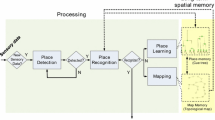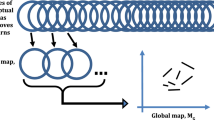Abstract
In this paper we propose the use of small global memory for a viewer’s immediate surroundings to assist in recognising places that have been visited previously. We call this global memory a Memory for the Immediate Surroundings (MFIS). Our previous work [1, 2] on building a cognitive map has focused on computing a representation for the different local spaces the viewer visits. The different local spaces which are computed can be connected together in the way they are experienced to form a topological network which is one aspect of a cognitive map of the spatial environment. The problem with topological representations is that using them one cannot easily detect that one is reentering a previously visited part of the environment if it is approached from a different side to the one used previously. Thus we have developed a cognitive map representation which comprises an MFIS working in cooperation with the topological network. The idea that a global map is present as part of the cognitive mapping process is increasingly appealing. Robotics researchers have used them from the early days of autonomous mobile robots. However, they have shown that it is difficult to compute an accurate global representation because of errors. There is now increasing evidence that a global map is used in animals and many simulation models have incorporated the use of such a map. In this paper we review these works, discuss this notion of a global map in cognitive mapping, and show how one could be computed with minimum effort.
Access this chapter
Tax calculation will be finalised at checkout
Purchases are for personal use only
Preview
Unable to display preview. Download preview PDF.
Similar content being viewed by others
References
Jefferies, M.E. and Yeap, W.-K.: Representing the local space qualitatively in a cognitive map. In: Proceedings of the Twelfth Annual meeting of the Cognitive Science Society. Madison, Wisconsin. (1998). 525–530
Yeap, W.K. and Jefferies, M.E.: Computing a representation of the local environment. Artificial Intelligence, 107 (1999) 265–301
Gallistel, C.R. and Cramer, A.E.: Computations on metric maps in mammals: getting oriented and choosing a multi-destination route. The Journal of Experimental Biology, 199 (1996) 211–217
Golledge, R.G., Dougherty, V., and Bell, S.: Acquiring spatial knowledge: survey versus route-based knowledge in unfamiliar environments. Annals of the Association of American Geographers, 85(1) (1995) 134–158
Hermer, L.: Internally coherent spatial memories in a mammal. Neuroreport, 8 (1997) 1743–1747
Kortenkamp, D. and Weymouth, T.: Topological mapping for mobile robots using a combination of sonar and vision sensing. In: Proceedings of the 12th AAAI. (1994). 979–984
Kuipers, B.: The spatial semantic hierarchy. Artificial Intelligence, 119 (2000) 191–233
Langley, P., Pfleger, K., and Sahami, M.: Lazy acquisition of place knowledge. Artificial Intelligence Review, 11 (1997) 315–342
Yeap, W.K. and Jefferies, M.E.: On early cognitive mapping. To appear, (2001)
Yeap, W.K.: Towards a Computational Theory of Cognitive Maps. Artificial Intelligence, 34 (1988) 297–360
Kuipers, B. and Byun, Y.-T.: A robot exploration and mapping strategy based on a semantic hierarchy of spatial representations. Journal of Robotics and Autonomous Systems, 8 (1991) 47–63
Yeap, W.K., Jefferies, M., and Naylor, P.: An MFIS for computing a raw cognitive map. In: Proceedings of the 12th International Joint Conference on Artificial Intelligence. (1991)
Kuipers, B., Froom, R., Lee, W.-Y., and Pierce, D.: The semantic hierarchy in robot learning. In: Robot Learning, Connell, J. and Mahadevan, S., (eds.): Kluwer Academic Publishers. (1993)
Thrun, S.: Learning metric-topological maps for indoor mobile robot navigation. Artificial Intelligence, 99(1) (1998) 21–71
Chatila, R. and Laumond, J.-P.: Position referencing and consistent world modelling for mobile robots. In: Proceedings of the 1985 IEEE International Conference on Robotics and Automation. (1985)
Biegler, R.: Possible uses of path integration in animal navigation. Animal Learning and Behaviour, 28(3) (2000) 257–277
Etienne, A.S., Maurer, R., Georgakopoulos, J, and Griffin, A.: Dead reckoning (path integration), landmarks, and representation of space in a comparative perspective. In: Wayfinding Behavior–Cognitive Mapping and other Spatial Processes, Golledge, R.G. (ed.): Baltimore: The Johns Hopkins University Press. (1999) 197–228
Gallistel, C.R.: The Organisation of Learning: Cambridge, MA: Bradford Books/MIT Press. (1990)
Loomis, J.M., Klatzky, R.L., Golledge, R.G., and Philbeck, J.W.: Human navigation by path integration. In: Wayfinding Behavior–Cognitive Mapping and other Spatial Processes, Golledge, R.G. (ed.): Baltimore: The Johns Hopkins University Press. (1999) 125–151
Maurer, R. and Seguinot, V.: What is modelling for? A critical review of the models of path integration. Journal of Theoretical Biology, 175 (1995) 457–475
McNaughton, B.L., Knierim, J.J., and Wilson, M.A.: Vector encoding and the vestibular foundations of spatial cognition: Neurophysiological and computational mechanisms. In: The Cognitive Neurosciences, Gazzaniga, M.S. (ed.) Cambridge, MA: Bradford/MIT press. (1995)
Cheng, K.: A Purely Geometric Module in the Rat’s Spatial Representation. Cognition, 23 (1986) 149–178
Margules, J. and Gallistel, C.R.: Heading in the rat: determination by environmental shape. Animal Learning and Behaviour, 16(4) (1988) 404–410
Benhamou, S.: On systems of reference involved in spatial memory. Behavioural Processes, 40 (1997) 149–163
Mittelstaedt, H. and Mittelstaedt, M.L.: Homing by path integration. In: Avian Navigation, Papi, F. and Wallraff, H.G. (eds.) Berlin: Springer Verlag. (1982)
Muller, M. and Wehner, R.: The hidden spiral: Systematic search and path integration n ants, cataglyphis fortis. Journal of Comparative Psychology A, 175 (1994) 525–530
Redish, A.D. and Touretzky, D.S.: Navigating with landmarks: Computing goal locations from place codes. In: Symbolic Learning, Ikeuchi, K. and Veloso, M. (eds.) Oxford University Press. (1996)
Chatila, R.: Path planning and environment learning in a mobile robot system. In: Proceedings of the European Conference on Artificial Intelligence. (1982)
Crowley, J.L.: Dynamic world modelling for an intelligent mobile robot using a rotating ultra-sonic ranging device. In: Proceedings of the 1985 IEEE International Conference on Robotics and Automation. (1985) 128–135
Pagac, D., Nebot, E.M., and Durrant-Whyte, H.: An evidental approach to map-building for autonomous vehicles. IEEE Transactions on Robotics and Automation, 14(4) (1998) 623–629
Elfes, A.: Using occupancy grids for mobile robot perception and navigation. IEEE Computer, June (1989) 46–57
Moravec, H.P.: Sensor fusion in certainty grids for mobile robots. AI Magazine, Summer (1988) 61–64
Author information
Authors and Affiliations
Editor information
Editors and Affiliations
Rights and permissions
Copyright information
© 2001 Springer-Verlag Berlin Heidelberg
About this paper
Cite this paper
Jefferies, M.E., Yeap, W. (2001). The Utility of Global Representations in a Cognitive Map. In: Montello, D.R. (eds) Spatial Information Theory. COSIT 2001. Lecture Notes in Computer Science, vol 2205. Springer, Berlin, Heidelberg. https://doi.org/10.1007/3-540-45424-1_16
Download citation
DOI: https://doi.org/10.1007/3-540-45424-1_16
Published:
Publisher Name: Springer, Berlin, Heidelberg
Print ISBN: 978-3-540-42613-4
Online ISBN: 978-3-540-45424-3
eBook Packages: Springer Book Archive




